In the matter of software testing , we always think about assessing a software product against its features and requirements. Along with building fully-functional software products that meet end users’ requirements, it is equally essential to understand how they perform exposed to external conditions.
If a software product after release does not satisfy customers’ expectations in terms of reliability, scalability, stability, and speed, they are not likely to use the product anymore. This, in turn, puts an organization's reputation and trustworthy relationship with customers at risk. And this is where the role of performance testing comes into play.
It is a type of software testing that validates software products for their performance, i.e., responsiveness and stability, under a certain workload. It determines whether the software product can withstand the load or not.
This blog post aims at introducing you to performance testing, its types, the entire process, and some popular tools to carry it out.
So. let us start our discussion!
What is Performance Testing?
It is a kind of non-functional testing technique that entails determining how a specific software product behaves or performs under the given workload. To put it simply, it is all about testing the capability, reliability, and quality of the software product under varying workloads. In addition, it determines how quickly the product responds to users’ requests, which we often refer to as response time.
The primary objective of performance testing is to spot and eliminate performance issues in the software product. Often, it is referred to as Perf testing. It determines whether the software product satisfies the specified requirements for stability, speed, and scalability.
Without Perf testing, the performance of the software product gets affected by slow response times, inconsistencies across various operating systems, and poor usability, which overall creates a poor user experience.
The following are the key attributes that Perf testing takes into account while validating software products:
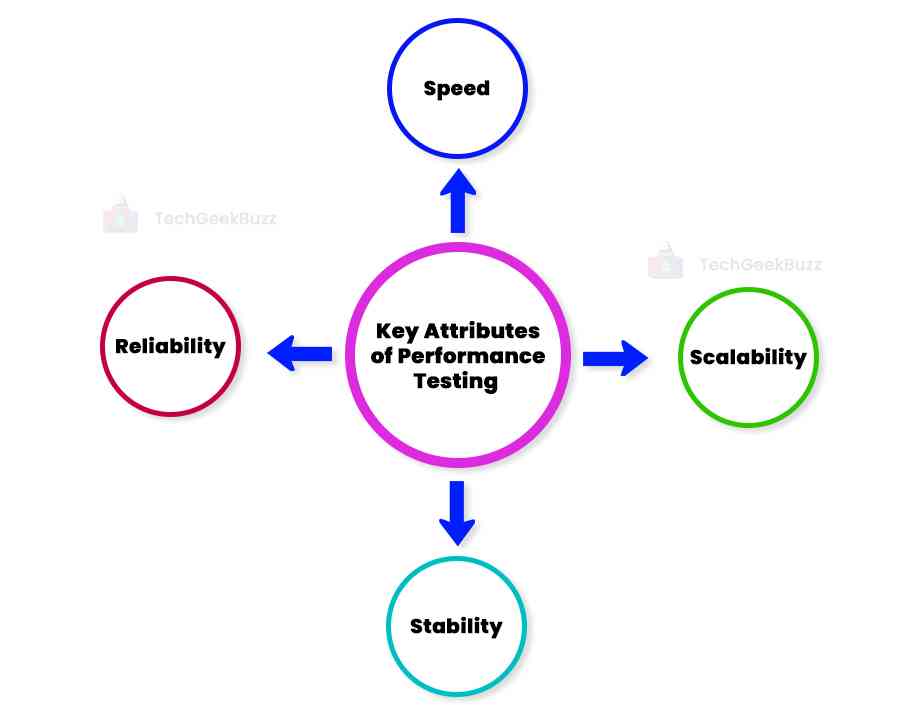
- Speed: It determines the time required for an application to respond to users' requests.
- Scalability: It checks the maximum user load the application can handle.
- Stability: It assesses whether the application is stable or not under varying workloads.
- Reliability: It determines the security of the application.
Importance of Performance Testing
As discussed above, the foremost goal of this type of software testing is to locate and fix performance bottlenecks within the software application. Here, a bottleneck is either a single point or component of the software product that affects its overall performance. This type of testing helps uncover the parts of software applications that need improvement before going live in the market.
Let us say that you created an excellent software application equipped with a variety of features and functionalities. Also, you got it tested and verified the application functionally by the testing team. And it seems like the application is ready to launch in the market and engage a lot of users.
You skipped the performance testing of your application and moved forward to release it to the end users.
After an immediate launch, consider that your application is experiencing amazing traffic. Let us say 2000 visitors per day. With this much number of visitors every day, your application is running efficiently. The number of visitors increases every day as your application’s visibility increases, i.e., from two thousand to four thousand, and so on, till the traffic count reaches 20 thousand. All of a sudden, your application stops working and shuts down. Trying to figure out why?
This is because your application was not ready to handle enormous user requests simultaneously beyond certain traffic. As more and more users were accessing your application, it started slowing down and suddenly stopped working. This all happened because you did not test your application against speed and performance under extreme workloads.
When your application undergoes Perf testing, you can easily find out all the performance issues and fix them before releasing the application to end users.
Objectives of Performance Testing
Let us shed some light on the objectives of Perf testing.
- Eliminates performance congestions or bottlenecks.
- Uncovers parts of the application that require improvements before releasing that application to the market.
- Makes the application perform faster and more rapidly.
- Turns the application into reliable and stable.
Performance Testing Metrics
Here are a few significant parameters monitored while carrying out Perf testing:
- Memory Use: It is the total amount of memory available to different processes on a system.
- CPU Use: It is the amount of time the processor executes non-idle threads.
- Disk Time: It is the amount of time the disk spends to implement read or write requests.
- Bandwidth: It implies the amount of data transmitted and received during a specific time period.
- Committed Memory: It refers to the amount of virtual memory utilized.
- Response Time: It is the total time from the time the user issues a request to the time the user receives the first character of the response.
- Memory Pages/Second: It implies the total number of pages written to or read from the disk in a second to overcome hard page faults.
- CPU Interrupts/Second: It is the average quantity of hardware interruptions that a processor receives and handles per second.
- Page Faults/Second: It is the total number of fault pages the processor processes in one second.
- Disk Queue Length: It is the average number of read and write requests that were waiting in line for the chosen disk during a sample interval.
- Network Output Queue Length: It refers to the length of the output packet queue in packets.
- Network Bytes Total/Second: It defines the rate at which the bytes are sent and received on an interface.
- Maximum Active Sessions: They are the total number of sessions that are active at a given time.
- Thread Count: The total number of threads that are running currently or are active, which provides the health of an application.
- Throughput: It refers to the total number of user requests the application receives in a specific time.
- Hit Ratios: It represents the total number of SQL statements the cache data handles rather than extensive I/O operations.
- Amount of Connection Pooling: It determines the total number of user requests a pooled connection can handle. The performance will improve as more requests are fulfilled by connections in the pool.
Common Performance Problems
The typical problems pertaining to the performance of an application revolve around its speed, scalability, responsiveness, and load time. Speed plays a vital role in the performance because users are in no way interested in using slow-running applications. As a result, to ensure applications run fast, Perf testing comes into play.
We have listed some of the most typical performance issues encountered while testing applications where speed plays a crucial role:
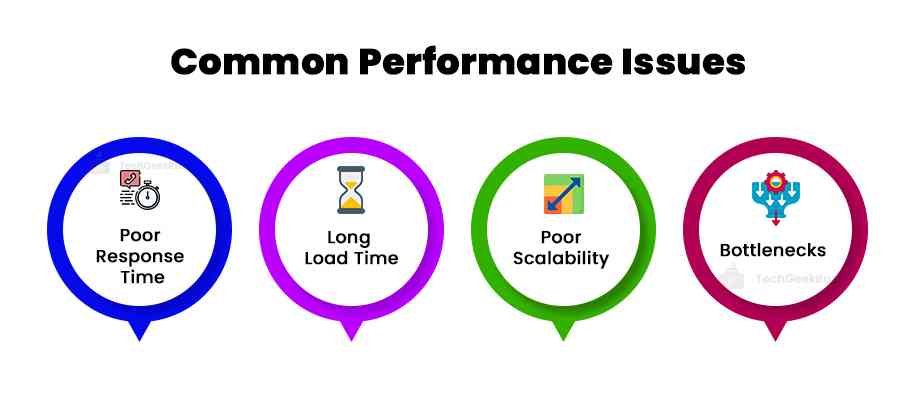
-
Poor Response Time
As discussed earlier, response time is the total time that starts when a user issues a request to an application and ends when the application sends the first character of its response. This process has to be very fast because users don’t like to wait for a long time. If the response time is maximum, they lose interest in the application.
-
Long Load Time
The load time is the time an application takes to start. Generally, this time should be minimum as users always want the application they use to start within a few seconds. If the application is not able to load within a few seconds, users find it boring to use.
-
Poor Scalability
When the application is not capable of handling multiple user requests simultaneously or cannot accommodate a large number of users, it results in a poor scalable application. To make sure that the application can handle a certain amount of requests, load testing comes in handy.
-
Bottlenecks
Bottlenecks are any obstacles in the application that affect its overall performance. Even a single faulty section of code can result in bottlenecks. As a result, the primary solution to fix bottlenecks is to locate and fix the section of code that causes the application to slow down.
The following are some examples of bottlenecks:
- Memory utilization
- Operating system constraints
- CPU utilization
- Network utilization
- Disk usage
Types of Performance Testing
In order to determine the performance of the application, it undergoes different types of Perf testing, as follows:
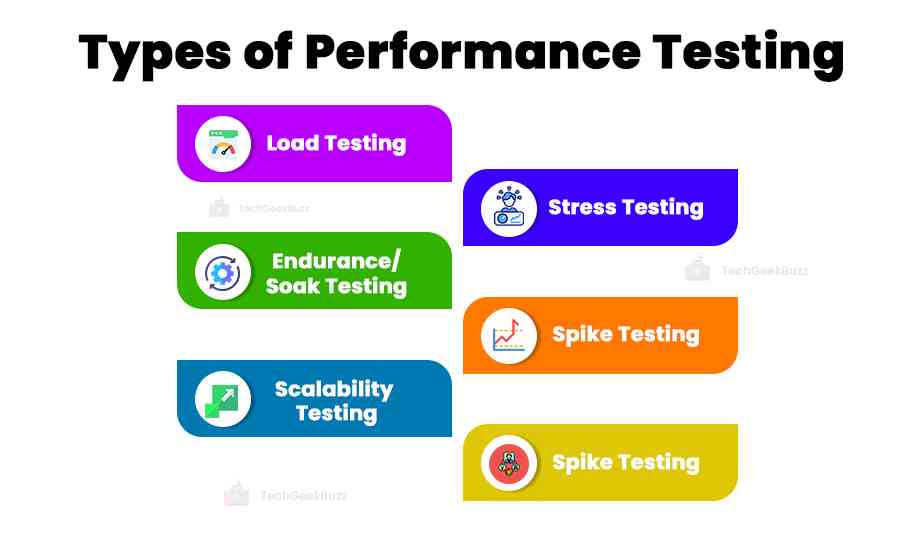
-
Load Testing
This type of testing helps determine how the application behaves when provided with a certain amount of workload. During this testing process, the testing team estimates the total number of concurrent users of the application and simulates them for a specific time period to uncover bottlenecks and assess the response time.
It determines the total number of users the application can withstand simultaneously before releasing it to the market.
-
Stress Testing
This kind of testing involves putting the application under an extreme load beyond its capacity to check how it performs, handles high traffic, and processes user requests. The primary objective is to identify the breaking point of an application.
The one who performs stress testing puts strain on hardware resources and identifies the breaking point of an application. These resources include CPUs, SSDs, memory, and hard drives.
-
Endurance/Soak Testing
Endurance testing or soak testing, a subset of stress testing, determines the amount of time the application can work smoothly with the expected load. In short, this testing validates the application for long-term sustainability. It entails measuring various performance metrics, such as memory usage, checks for failure, throughput, and response time.
-
Spike Testing
Spike testing is also a type of stress testing that determines the behavior of the application when there is a sudden and extreme spike in load by users. It checks whether or not the application can handle the sudden increase in workload.
-
Scalability Testing
This type of testing helps verify the application’s ability to scale up and down based on the workload available. It helps you to decide what capacity to add to your application.
-
Capacity Testing
Capacity testing determines if a software program can manage the volume of traffic for which it was created.
Performance Testing Process
The process of performance testing varies depending on the types of performance metrics selected. Also, it varies from organization to organization. However, it is important to note that the objective of Perf testing remains the same, regardless of the approach used.
Here is a generic process for carrying out performance testing:
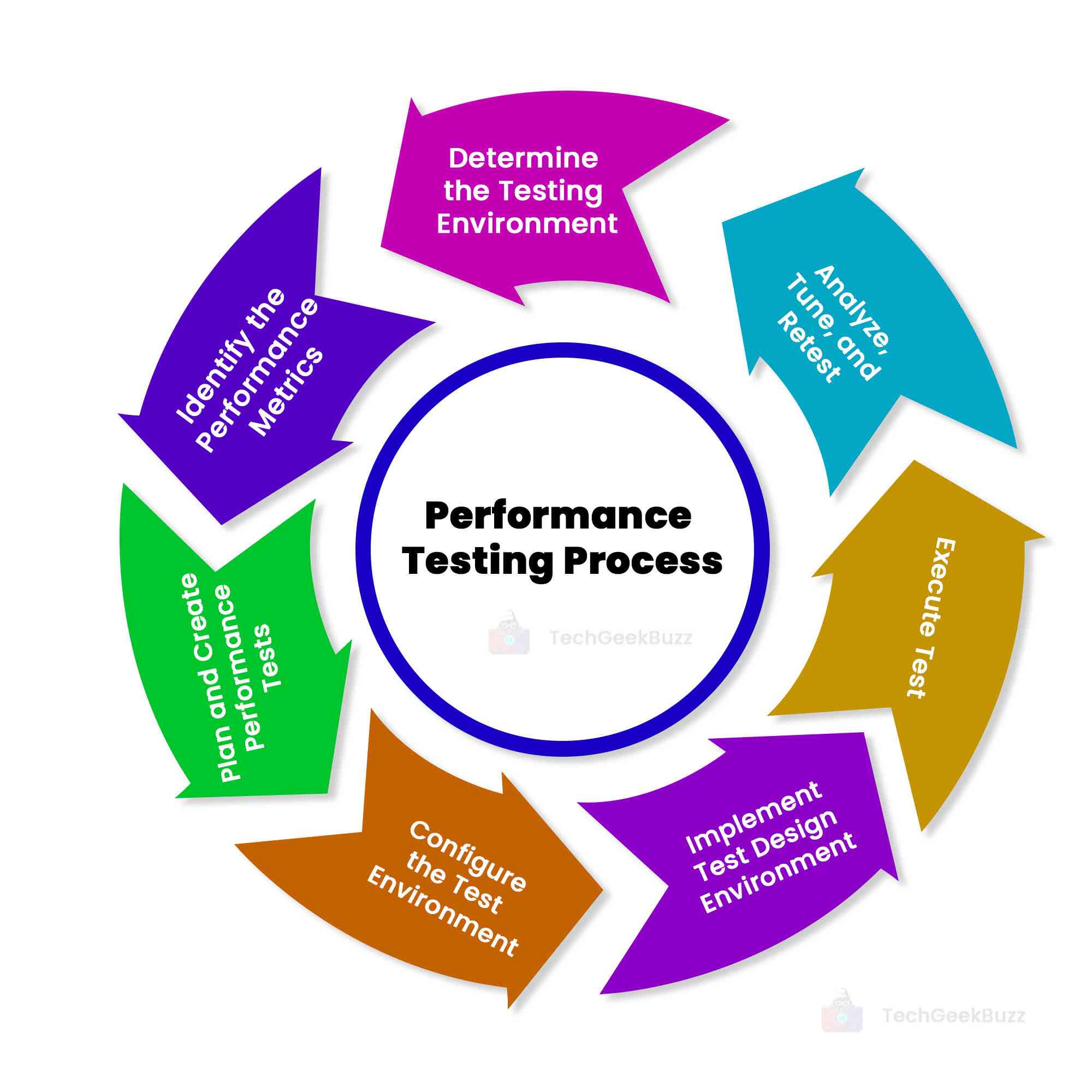
1. Determine the Testing Environment
Before commencing the testing process, it is essential to have an in-depth understanding of the physical test environment, production environment, and available testing tools. In addition, make sure to learn the details of hardware, software, and network configurations required during the testing process. Doing this helps design and create more effective tests.
2. Identify the Performance Metrics
At this stage, you need to decide on the goals, thresholds, and constraints that will serve as success criteria for the test. Though the significant criteria will be decided from the project’s specifications, test professionals should also be well-equipped to set some other benchmarks.
3. Plan and Create Performance Tests
You must consider the application's varied usage patterns. Based on this consideration, design test cases that cover all possible use cases. After designing test cases, make sure to outline performance metrics that need to be monitored.
4. Configure the Test Environment
Make sure you have all the necessary testing tools in hand and the testing environment ready before you commence the testing process.
5. Implement Test Designs
As you have already decided on the performance metrics or criteria and planned what performance test cases to create, now it is time to implement them.
6. Execute Test
Now, run those performance tests and capture and monitor the test results.
7. Analyze, Tune, and Retest
After executing every performance test, analyze the results generated and share them with the team. Make the necessary changes to the application based on the shortcoming you identified through testing. Finally, carry out the test again to ensure each issue has been resolved.
Performance Test Tools
The internet is replete with a variety of performance testing tools . There are certain factors you should take into consideration while selecting a tool for Perf testing. Some of these factors include hardware requirements, license cost, platform support, etc.
Here we have listed some of the most popular tools you can take into account for Perf Testing:
1. LoadNinja
It is a cloud-based performance test tool with an easy-to-use interface and no learning curve. Anyone, even a novice, can load test applications with LoadNinja. It lets you record and playback load tests without any dynamic correlations and programming, unlike other traditional tools.
Additionally, this tool supports load testing with real browsers, analyzes performance in real time, and automates load tests.
2. HeadSpin
It is the best mobile application performance optimization tool. Also, this tool lets you test networks and devices to identify performance bottlenecks. You get the performance data from real-world conditions with the help of HeadSpin’s Global Device Infrastructure. More interestingly, this tool leverages AI capabilities to detect performance issues.
3. BlazeMeter
It is a perfect solution for everyone looking to get everything required for the testing process under a single platform. It combines everything from mobile to mainframe and IDEs to UI with shared visibility, tests, and reports. The best feature of this tool is that it blends performance, scriptless, functional, and API testing. Test data and mock services are also parts of this tool that make creating and managing test data easy.
4. HP LoadRunner
This tool significantly simplifies load and performance testing. It supports Perf testing for a broad spectrum of protocols and over 50 different technologies and application environments. It comes with a patent auto-correction engine that helps you spot performance issues easily. You can even use this tool for continuous testing.
5. JMeter
It is a popular performance testing tool for assessing static as well as dynamic resources for their performance. It also tests different types of protocols, web services, servers, and different types of applications. The test IDE lets users create test cases easily.
Conclusion
This was the complete guide on performance testing. It is a type of non-functional testing technique that validates software applications for their reliability, stability, scalability, and speed. The role of Perf testing is equally important as testing the software product against its features and functionalities. It ensures that the software product is able to handle a massive load and will not shut down suddenly, even if there is an abrupt increase in user requests.
People are also reading:
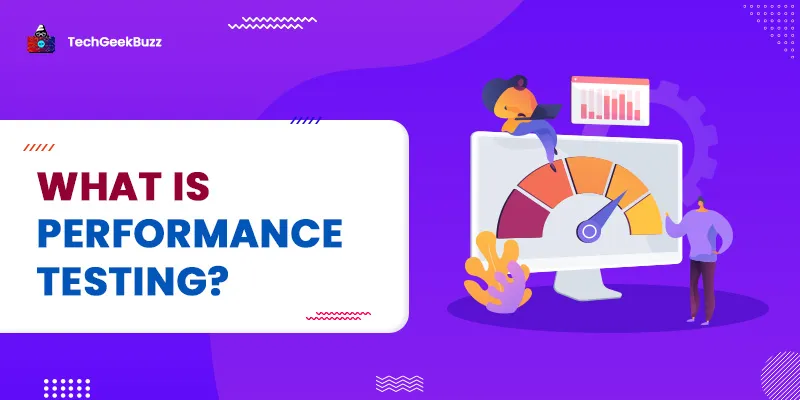

![What is Waterfall Model? [Phases, Pros, & Cons]](/media/new_post_images/Waterfall_Model.webp)


Leave a Comment on this Post